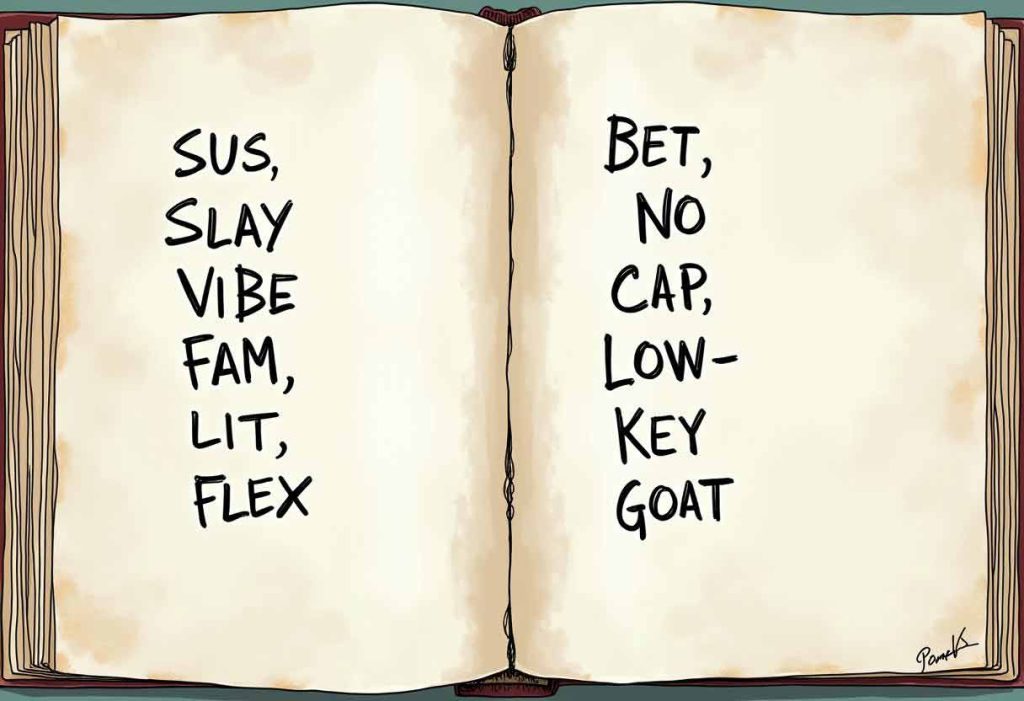Introduction
Have you ever tried to spice up a conversation with a trendy slang term only to see the energy in the room fizzle out? Or hesitated before texting your boss, wondering if saying “This project is lit!” might jeopardize your career? You’re not alone. While slang can add color, personality, and humor to our communication, it also carries risks when used in the wrong context.
This guide offers practical strategies for using slang tastefully. We’ll explore why slang etiquette matters, when to use it, and when to hold back. From industry-specific jargon and regional variations to cross-cultural nuances and remote-work etiquette, you’ll find diagrams, decision trees, and real-world case studies to help you navigate slang with confidence. Let’s turn those awkward pauses into meaningful connections!
Quick-Reference Summary (Key Takeaways)
- Context is King: Always consider the setting (professional, social, cultural) before using slang.
- Know Your Audience: Tailor your language to your listeners—consider age, culture, and industry.
- Read Non-Verbal Cues: Observe facial expressions, body language, and tone to gauge if your slang is connecting or missing the mark.
- Use Slang Sparingly: Often, less is more; avoid overloading your speech with unfamiliar terms.
- Have a Recovery Plan: If your slang misfires, offer a brief apology, rephrase, and move on.
- Stay Informed and Respectful: Understand the cultural or historical origins of the words you choose.
- Practice Code-Switching: Adapt smoothly between formal and informal language as needed.
- Evolve With Language: Slang changes quickly—stay updated without forcing usage.
- Pro Tip: When in doubt, stick to standard language. You can always relax your tone if the situation allows later.
The Role of Slang
Why Slang Matters
Slang serves as a cultural handshake—a way to signal belonging to a particular group, place, or era. Whether it’s a playful “Yo, what’s poppin’?” among friends or a quick “Bet” in a text, slang can create bonds through shared language and inside jokes. However, slang etiquette is a moving target; what feels fresh today might be outdated tomorrow.
Building (and Sometimes Breaking) Bridges
Used correctly, slang fosters closeness and camaraderie. Used poorly, it can lead to confusion or even offense. For example, a well-timed “That’s so sus” might spark laughter with your gamer pals, but leave your grandmother puzzled at a family reunion. Context is everything.
Case Study: Slang Win vs. Slang Fail
- Win: During a casual team lunch, a coworker exclaims, “That presentation was fire!”—sparking smiles and immediate enthusiasm.
- Fail: Using “That court hearing was fire!” when speaking with a senior legal partner results in awkward silence and puzzled looks.
Table of Contents
- Introduction
- Quick-Reference Summary (Key Takeaways)
- The Role of Slang
- Part 1 – Professional Settings
- Part 2 – Social & Family Contexts
- Part 3 – Digital vs. Real-World Communication
- Part 4 – Cross-Cultural and International Considerations
- Part 5 – Slang Risk Assessment & Recovery
- Part 6 – Specialty Scenarios
- Visual Aids & Practice Exercises
- Conclusion
Part 1 – Professional Settings
Traditional Offices vs. Startups
- Traditional Offices: In environments like finance, law, or corporate headquarters, clarity and professionalism are prized. Slang should be minimal or reserved for off-the-clock moments.
- Creative Startups: Tech companies and marketing agencies often embrace a casual tone. If your Slack channels are filled with memes and emojis, a well-placed “This campaign idea is lit!” might fit right in.
Industry-Specific Slang
Jargon often overlaps with slang. In fields such as tech, medicine, or law, ensure your audience understands specialized terms:
- Tech: “MVP” (Minimum Viable Product), “DevOps,” “scrum”
- Medical: “Stat” (immediately), “code blue” (cardiac or respiratory arrest)
- Legal: “Tort,” “lien,” “discovery”
Real-World Example:
As a junior developer excited about a new project, instead of saying “This new code is dope,” try “I’m really excited about the efficiency of this new feature.” It’s both professional and enthusiastic.
Remote Work Environments
Digital communication lacks the non-verbal cues of in-person interactions. Start conversations formally until you understand your team’s communication style. If colleagues casually drop slang, you can adapt—when in doubt, play it safe.
Tip: Digital communications can be saved, screenshotted, or forwarded. A lighthearted slang term among peers might be misinterpreted if viewed by a client or executive.
Part 2 – Social & Family Contexts
Friend Groups
Close friends often develop their own slang, inside jokes, and playful banter. Experiment freely if you’re comfortable with the terms—but make sure your language matches the group’s vibe.
Mini-Case Study:
- Success: In a group that loves pop-culture memes, someone says, “I’m dead!” and you reply, “Same, I can’t breathe,” blending in seamlessly.
- Misfire: Introducing a brand-new slang term you’ve only read online might fall flat or seem off-putting.

Family Gatherings
Generational gaps can turn “That’s lit!” into “That’s what?” If older family members aren’t familiar with modern slang, either explain the term or choose more traditional phrases. Conversely, using tasteful slang with younger relatives can show respect for their culture—without overdoing it.
Non-Verbal Cue Check
- Positive: Smiles, nods, or playful responses.
- Negative: Furrowed brows, confused looks, or abrupt changes in conversation.
Regional Variations
Slang varies even within the same language. What is acceptable in one region may be rude in another. For instance, “Bless your heart” can be either endearing or passive-aggressive. Listen first, then adopt local expressions.
Part 3 – Digital vs. Real-World Communication
Social Media Do’s and Don’ts
Social media is fast-paced—a phrase might trend one week and be considered outdated the next. Platforms like TikTok or Twitter showcase fresh slang, but remember that your online persona lasts. Employers, professors, or future clients may view your posts.
- TikTok and Twitter: Embrace casual, creative slang.
- LinkedIn: Maintain professionalism with minimal slang.
- Facebook/Instagram: Be mindful of a mixed audience including family and coworkers.
Face-to-Face Interactions
In-person conversations allow you to quickly clarify slang if someone is confused. A simple “I just mean it’s awesome” can clear up misunderstandings. However, if your slang offends, you’ll notice immediately—adjust accordingly.
Part 4 – Cross-Cultural and International Considerations
Cultural Roots and Code-Switching
Many popular English slang terms originate in African American Vernacular English (AAVE), Latinx communities, or other minority cultures. Respecting these roots means acknowledging their origins and avoiding caricatures. Code-switching—the ability to shift between different language styles—is a valuable skill. Practice balancing natural speech with cultural sensitivity.
Traveling Abroad
Slang that’s acceptable at home may be offensive abroad. A simple question like, “Is this okay to say here?” can help avoid major social gaffes. Learning local slang from language guides or cultural exchange groups also shows respect and openness.
Part 5 – Slang Risk Assessment & Recovery
Decision Tree for Slang Usage
- Context:
- Is the setting formal/professional or casual?
- If formal, avoid slang and switch to standard language.
- If casual, proceed.
- Is the setting formal/professional or casual?
- Audience:
- Do they already use this slang?
- If yes, you’re likely safe.
- If no, consider age, cultural background, and comfort level.
- Do they already use this slang?
- Relevance:
- Does the slang add clarity or connection?
- If yes, use it.
- If no, leave it out.
- Does the slang add clarity or connection?
“Slang Risk Assessment” Checklist
- Have I heard my audience use similar slang?
- Am I clear on the term’s meaning and origin?
- Is the situation light or serious?
- Could this term be misinterpreted as offensive?
- Am I prepared to explain or defend my choice if questioned?
Recovery Phrases
If you notice awkwardness or offense:
- “Sorry about that—let me rephrase.”
- “I realize that may not be clear; I just meant it’s really exciting.”
- “My apologies—that term might not fit this context. Let’s continue.”
Part 6 – Specialty Scenarios
Educational Settings
Teachers and professors strive for clarity and authority. While a touch of slang can engage students, overusing it may undermine credibility. For instance, saying “That’s fire!” might work in an informal workshop but could distract during a formal lecture.
Customer Service Interactions
In customer-facing roles, clarity and respect are paramount. Too much slang may appear unprofessional or confuse customers. A friendly greeting like “Hi there!” or “Gotcha!” works well—just ensure it aligns with your brand’s voice.
Mental Health Contexts
When discussing mental health, maintain a gentle and empathetic tone. Avoid slang that trivializes serious issues; use respectful and direct language to provide genuine support.
Slang and Gender
Some slang carries gender-specific undertones. Terms like “bro,” “dude,” or “sis” might resonate with some groups while alienating others—especially if the term doesn’t align with someone’s identity. When in doubt, opt for neutral terms like “friend” or simply use the person’s name.
Visual Aids & Practice Exercises
Context Thermometer
Imagine a thermometer divided into zones:
- Red (High-Formality): Legal/medical consultations, academic conferences, job interviews.
- Orange (Moderate-Formality): Most workplaces, cross-generational gatherings, LinkedIn posts.
- Green (Casual): Close friends, social media, relaxed chats.
Role-Play Scenarios
- Scenario 1: You’re on a Zoom meeting with a new team. Practice greeting them in both a formal style and a casual tone. Which approach feels right?
- Scenario 2: A friend from another state uses a regional slang phrase you’re unfamiliar with. Respond in a way that politely asks for clarification.
Exercises to Practice
- Identify the Setting: For each scenario (office meeting, family gathering, online gaming chat), list three slang terms that might work and three that might not.
- Rewrite the Message: Convert a formal sentence into a casual one, then reverse the process.
- Slang Dictionary Search: Look up five slang terms you’ve recently heard. Note their origins, cultural contexts, and potential pitfalls.
Slang Table
| Slang Term | Meaning | Typical Context |
|---|---|---|
| Sus | Suspicious or questionable | Gaming chats, youth slang |
| Bet | Agreement or confirmation (“sure”) | Quick, informal text exchanges |
| Slay | Doing something impressively well | Social media praise (e.g., “You slay!”) |
| Vibe | Atmosphere or overall mood | Chill gatherings (e.g., “The vibe is so chill.”) |
| No Cap | Truthful, no lie | Casual conversations; rap culture origins |
| Fam | Close friends or group | Warm, friendly greetings (e.g., “Hey fam!”) |
| Low-Key | Subtly, mildly | Quiet preferences (e.g., “I’m low-key excited.”) |
| Lit | Exciting, fun, or amazing | Parties, casual hangouts (e.g., “This party is lit!”) |
| Flex | To show off or boast | Teasing or playful bragging (e.g., “Don’t flex!”) |
| Spill the Tea | Reveal gossip or inside info | Casual chats, social media (e.g., “Girl, spill the tea.”) |
| GOAT | Greatest of All Time | Sports, pop culture debates (e.g., “He’s the GOAT!”) |
| Throw Shade | Subtly criticize or insult | Online drama, social media (e.g., “She’s throwing shade.”) |
| Woke | Socially aware | Discussions on social issues (e.g., “Stay woke, y’all.”) |

Conclusion
Using slang effectively isn’t about memorizing every trendy term or trying to sound like the “cool kid.” It’s about reading the context, respecting cultural roots, and tailoring your language to fit the situation. Whether you’re in a boardroom, a classroom, a family kitchen, or a group text, clear and authentic communication should always be your priority.
- Stay Curious: Language is ever-evolving; keep learning.
- Embrace Adaptability: Mastering code-switching is a valuable skill.
- Show Respect: Cultural awareness goes a long way.
- Prioritize Clarity: Ensure your message isn’t lost in translation.
When used mindfully, slang can spark a sense of belonging and fun in everyday conversations—without the awkward aftermath. For more insights, visuals, and real-life examples, visit our expanded resources at StreetSlang.com. Here’s to confident, inclusive conversations—wherever you may be chatting!


Leave a Reply